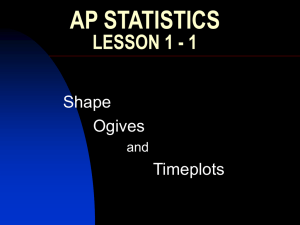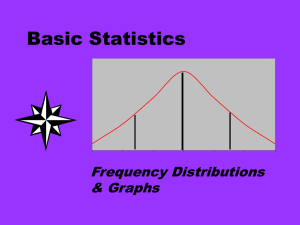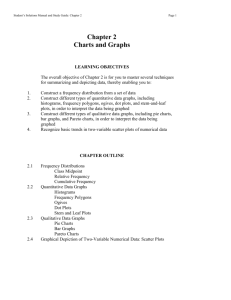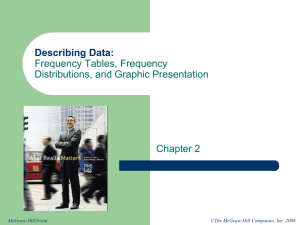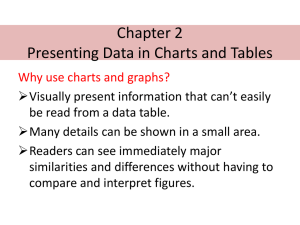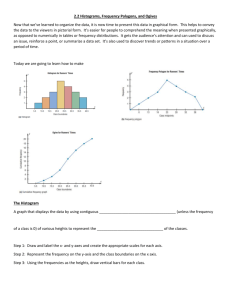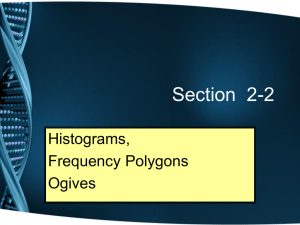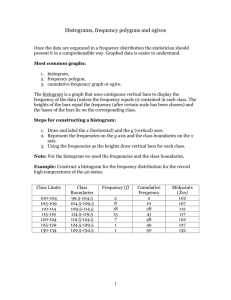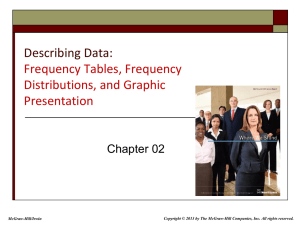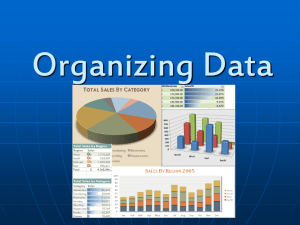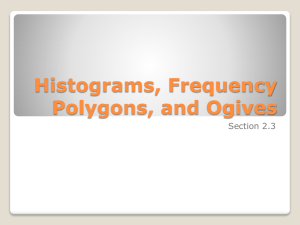MATH30-6 Lecture 2
advertisement
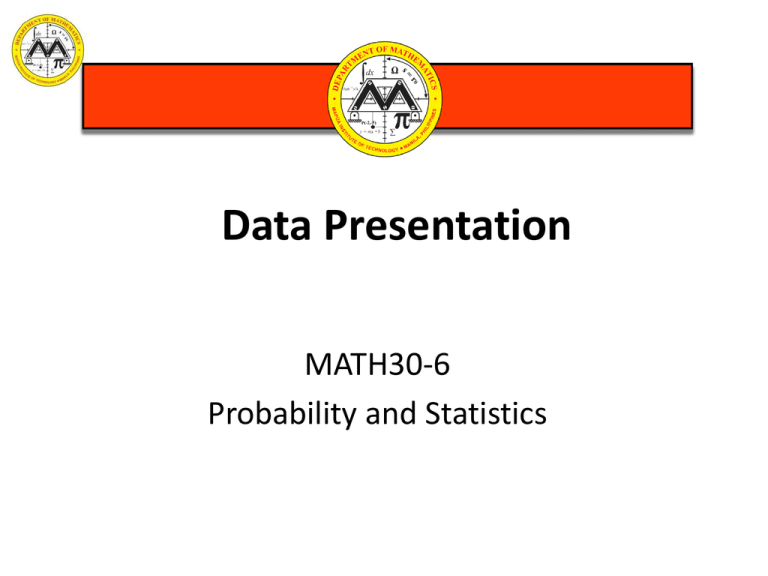
Data Presentation MATH30-6 Probability and Statistics Objectives At the end of the lesson, the students are expected to • Identify and learn various ways of presenting data; • Describe data through tables, graphs, and charts; • Describe and interpret data presented in various charts; and • Practice different ways or presenting data. Types of Data Presentation • Textual Form - Data presentation using sentences and paragraphs in describing data • Tabular Form - Data presentation that uses tables arranged in rows and columns for various parameters • Graphical Form - Pictorial representation of data Grouped and Ungrouped Data • Ungrouped Data - Data points are treated individually. • Grouped Data - Data points are treated and grouped according to categories. Data Presentation Stem-and-Leaf Diagram Steps to construct a stem-and-leaf diagram: 1. Divide each number xi into two parts: a stem, consisting of one or more of the leading digits, and a leaf, consisting of the remaining digit. 2. List the stem values in a vertical column. 3. Record the leaf for each observation beside its stem. 4. Write the units for stems and leaves on the display. Stem-and-Leaf Diagram Example: 1. Express the following data as a stem-and-leaf diagram with the tens digit as the stems and the ones digit as the leaves. 12, 23, 12, 11, 10, 25, 29, 39, 31, 43, 42, 54, 53, 53, 56, 57, 56, 67, 54, 65, 76, 76, 75, 74 Data Presentation Frequency Distribution Table Numerous data can be analyzed by grouping the data into different classes with equal class intervals and determining the number of observations that fall within each class. This procedure is done to lessen work done in treating each data individually by treating the data by group. Frequency Distribution Table Class limits - The smallest and the largest values that fall within the class interval (class) - Taken with equal number of significant figures as the given data. Class boundaries (true class limits) - More precise expression of the class interval - It is usually one significant digit more than the class limit. - Acquired as the midpoint of the upper limit of the lower class and the lower limit of the upper class Frequency Distribution Table Frequency - The number of observations falling within a particular class. - Counting and tallying Class width (class size) - Numerical difference between the upper and lower class boundaries of a class interval. Class mark (class midpoint) - Middle element of the class - It represents the entire class and it is usually symbolized by x. Frequency Distribution Table Cumulative Frequency Distribution - can be derived from the frequency distribution and can be also obtained by simply adding the class frequencies - Partial sums Types of Cumulative Frequency Distribution - Less than cumulative frequency (<cf) refers to the distribution whose frequencies are less than or below the upper class boundary they correspond to. - Greater than cumulative frequency (>cf) refers to the distribution whose frequencies are greater than or above the lower class boundary the correspond to. Frequency Distribution Table Relative Frequency - Percentage frequency of the class with respect to the total population - For presenting pie charts Relative Frequency (%rf) Distribution - The proportion in percent the frequency of each class to the total frequency - Obtained by dividing the class frequency by the total frequency, and multiplying the answer by 100 Frequency Distribution Table Class Interval Frequency x LCB UCB <cf >cf %rf Frequency Distribution Table Steps in Constructing a Frequency Distribution Table (FDT) 1. Get the lowest and the highest value in the distribution. We shall mark the highest and lowest value in the distribution. 2. Get the value of the range. The range denoted by R, refers to the difference between the highest and the lowest value in the distribution. Thus, R = H ─ L. Frequency Distribution Table 3. Determine the number of classes. In the determination of the number of classes, it should be noted that there is no standard method to follow. Generally, the number of classes must not be less than 5 and should not be more than 15. In some instances, however, the number of classes can be approximated by using the relation 𝑘 = 1 + 3.322 log 𝑛 (Sturges’ Formula), where k = number of classes and n = sample size. is the ceiling operator (meaning take the closest integer above the calculated value). Square root principle: 𝑘 = 𝑛 Frequency Distribution Table 4. Determine the size of the class interval. The value of C can be obtained by dividing the range by the desired number of classes. Hence, 𝐶 = 𝑅 𝑘. 5. Construct the classes. In constructing the classes, we first determine the lower limit of the distribution. The value of this lower limit can be chosen arbitrarily as long as the lowest value shall be on the first interval and the highest value to the last interval. Frequency Distribution Table 6. Determine the frequency of each class. The determination of the number of frequencies is done by counting the number of items that shall fall in each interval. Frequency Distribution Table 2. Using the steps discussed, construct the frequency distribution of the following results of a test in statistics of 50 students given below. 88 62 63 88 65 85 83 76 72 63 60 46 85 71 67 75 78 87 70 43 63 90 63 60 73 55 62 62 83 79 78 43 51 56 80 90 47 48 54 77 86 55 76 52 76 43 52 72 43 60 Frequency Distribution Table 2. Using the steps discussed, construct the frequency distribution of the following results of a test in statistics of 50 students given below. Answer: 88 62 63 88 65 Class Interval Frequency 85 83 76 72 63 43-49 7 60 46 85 71 67 50-56 7 75 78 87 70 43 57-63 10 63 90 63 60 73 55 62 62 83 79 64-70 3 78 43 51 56 80 71-77 9 90 47 48 54 77 78-84 6 86 55 76 52 76 85-91 8 43 52 72 43 60 Frequency Distribution Table 3. The following are the scores of 40 students in a Math quiz. Prepare a frequency distribution for these scores using a class size of 10. 22 31 55 76 48 49 50 85 17 38 92 62 94 88 72 65 63 25 88 88 86 75 37 41 76 64 66 58 66 76 52 40 42 76 29 72 59 42 54 62 Frequency Distribution Table 3. The following are the scores of 40 students in a Math quiz. Prepare a frequency distribution for these scores using a class size of 10. Answer: 22 31 55 76 48 49 50 85 17 38 Class Interval Frequency 17-26 3 27-36 2 37-46 6 47-56 6 57-66 9 67-76 7 77-86 2 87-96 5 92 62 94 88 72 65 63 25 88 88 86 75 37 41 76 64 66 58 66 76 52 40 42 76 29 72 59 42 54 62 Frequency Distribution Table 4. The thickness of a particular metal of an optical instrument was measured on 121 successive items as they came off a production line under what was believed to be normal conditions. The results are shown in Table 4.5. Frequency Distribution Table 4. Answer Data Presentation Graphical Form of Frequency Distribution Frequency Polygon - Line graph - The points are plotted at the midpoint of the classes. Histogram (Frequency Histogram or Relative Frequency Histogram) - Bar graph - Plotted at the exact lower limits of the classes Data Presentation Graphical Form of Frequency Distribution Ogive - Line graph - Graphical representation of the cumulative frequency distribution - The < ogive represents the <cf while the > ogive represents the >cf. Data Presentation 5. Construct a frequency polygon, histogram, and ogives of the given distribution. Class Interval Frequency 25-29 1 30-34 1 35-39 5 40-44 8 45-49 15 50-54 4 55-59 4 60-64 3 65-69 4 70-74 3 75-79 2 Data Presentation In the preparation of a polygon, the frequency values are always plotted on the y-axis (vertical) while the classes are plotted on the x-axis (horizontal). Here we use the class midpoints. Frequency Polygon 16 15 14 13 12 Frequency (f) 11 10 9 8 7 6 5 4 3 2 1 0 17 22 27 32 37 42 47 52 57 Class Midpoint (x) 62 67 72 77 82 87 Data Presentation The preparation of the histogram is similar to the construction of the frequency polygon. While the frequency polygon is plotted using the frequencies against the class midpoints, the histogram is plotted using the frequencies against the exact limit Frequency Histogram of the classes. 16 15 14 13 12 11 Frequency (f) 10 9 8 7 6 5 4 3 2 1 0 19.5 24.5 29.5 34.5 39.5 44.5 49.5 54.5 Exact Class Limit 59.5 64.5 69.5 74.5 79.5 Data Presentation Frequency Histogram Frequency Histogram 16 15 14 13 12 11 Frequency (f) 10 9 8 7 6 5 4 3 2 1 0 22 27 32 37 42 47 52 57 Class Midpoint (x) 62 67 72 77 82 Data Presentation Ogives Ogives 55 50 Cumulative Frequency (CF) 45 < ogive > ogive 40 35 30 25 20 15 10 5 0 19.5 24.5 29.5 34.5 39.5 44.5 49.5 54.5 Class Boundary (CB) 59.5 64.5 69.5 74.5 79.5 84.5 Data Presentation 6. Construct a frequency polygon, histogram, and ogives of the frequency distribution from problem #2. Class Interval Frequency 43-49 7 50-56 7 57-63 10 64-70 3 71-77 9 78-84 6 85-91 8 Summary • Stem-and-leaf diagram is one way of data presentation tabular form. • Frequency distribution can be depicted in two ways: tabular and graphical (frequency polygon, histogram, and ogives) forms. References • DeCoursey. Statistics and Probability for Engineering Applications with Microsoft® Excel © 2003 • Montgomery and Runger. Applied Statistics and Probability for Engineers, 5th Ed. © 2011
